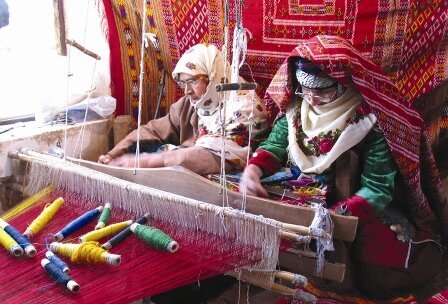Discover Zavin: The Heart of Iran’s Timeless Silk-Weaving Tradition
Discover the vibrant world of silk weaving in Zavin, a city in Kalat county, situated in the Khorasan Razavi province of Iran. Recognized as a national center for silk weaving in 2023, Zavin is a testament to the rich history and diverse culture of this fascinating region.
Silk weaving in Zavin is more than just a craft; it represents the art and creativity of local artisans while reflecting the historical and cultural legacy of the clans that have inhabited this area. According to reports from ISNA, this traditional craft has evolved over the centuries into a significant industry, serving as a vital source of income for many households.
As highlighted by a handicrafts specialist, the favorable weather and geographical conditions of Zavin make it an ideal location for breeding silkworms and producing high-quality natural silk. The expert noted, “This industry gradually became one of the economic and cultural pillars of the region, with many households actively involved in it.”
In addition to its economic impact, silk weaving is celebrated as both an art form and an industry in Zavin, crucial for preserving local culture and identity. The city of Kalat, particularly Zavin, is home to various ethnic groups, each with its unique customs and traditions, contributing to the area’s rich cultural tapestry.
Ethnic Diversity and Cultural Significance
The ethnic and cultural diversity in Zavin is one of its most distinctive characteristics. Each community brings its own special clothing styles and traditions, particularly evident during local ceremonies and celebrations.
- Tourist Attraction: Local attire is a significant tourist attraction in Kalat, showcasing the rich culture of the region.
- Ethnic Groups: Zavin is inhabited by diverse ethnic groups, including Turkmens and Kurds, each enriching the cultural diversity with their languages, customs, and traditions.
- Cultural Connections: Silk weaving stands as a common cultural element among these ethnic communities, fostering social and cultural ties.
The local clothing of Kalat is especially prominent during significant events such as weddings. As Khodsetan explained, “The garments produced in this region are not only beautiful and unique, but they also reflect the cultural identity of each ethnic group.” These clothes, made from natural fibers, feature diverse designs and colors and are specifically crafted for ceremonies and celebrations.
Local Clothing Designs
Khodsetan emphasized the uniqueness of Zavin’s local clothing designs, stating, “These garments attract attention with their vibrant colors and traditional patterns.” Typically, local clothing includes:
- Long skirts
- Beautiful blouses
- Various accessories enhancing their beauty
During wedding ceremonies, these traditional outfits symbolize the cultural and social identity of the bride and groom, embodying happiness and vitality. While most garments crafted in Zavin are utilized locally, some manufacturers are modernizing their products to participate in international exhibitions, which helps to introduce Zavin’s culture and art on a global scale.
Local Clothing Workshops
In Zavin, there are approximately 300 to 350 local clothing workshops dedicated to producing various traditional and silk garments. Each workshop is known for creating unique products that reflect the artistry and tastes of local artisans. Khodsetan remarked that these workshops are often family-run, which aids in preserving family traditions and passing skills to younger generations. She noted, “Women play a crucial role in these workshops and are recognized as the primary artists and producers of silk weaving.”
Local women are instrumental in crafting silk fabrics adorned with exquisite designs used during various ceremonies. The silk-weaving industry promotes collaboration between men and women, allowing them to share cultural experiences and reinforce community bonds.
The Challenge of Knowledge Transfer
One of the significant challenges facing the silk-weaving industry is the transfer of knowledge and skills to younger generations. While many elder women possess expertise in this art, younger individuals often show less interest. Therefore, organizing training workshops and courses for youth can play a vital role in preserving and promoting this ancient craft.
Khodsetan believes that these workshops could inspire younger generations to learn these skills and ensure their transmission to the future. She outlined that such training could cover:
- Practical skills in silk weaving
- Designing local dresses
- Familiarization with new production techniques
By enhancing the appeal of silk weaving in Zavin, it is anticipated that the craft will attract both domestic and foreign tourists, creating more job opportunities for local residents.
In conclusion, Zavin’s rich heritage of silk weaving not only stands as a testament to the creativity and skills of its people but also as a vital component of their cultural identity, promising a bright future for this traditional craft.






